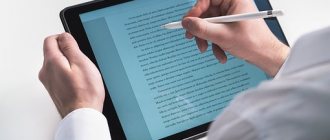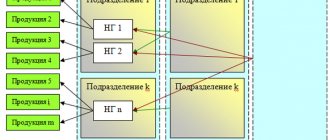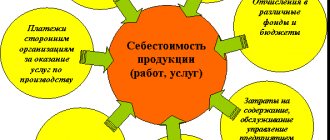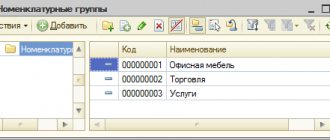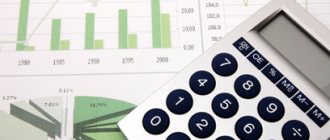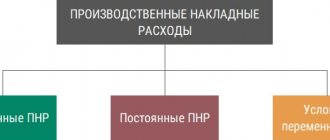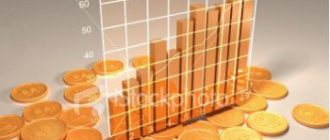Classification of methods for accounting for production costs and calculating costs
To begin with, let’s determine what the correct construction of a cost accounting methodology (hereinafter referred to as CM) can provide, who needs it and why.
The following management KM priorities can be identified:
- checking the correct flow of the production cycle;
- collecting information on costs to analyze them and find ways to optimize them;
- making decisions by management on other cost management issues.
The objects of KM and cost calculation most often differ. The first of these is the basis on which costs are sorted. The object of KM can be the place of its origin, the center of responsibility, the type or group of products, the type of resources. The second is the type of product (work, service), semi-finished products, products at different stages of readiness. To distinguish between the concept of knowledge management and the concept of cost calculation, we propose to consider a diagram.
The sequence of reflecting and calculating costs and costs consists of accounting (steps 1–5) and cost accounting (steps 4–6). These steps are interconnected, and their implementation provides data for cost management. At the moment, the literature on management accounting describes a large number of methods for cost accounting and calculating product costs . A unified generally accepted systematization has not yet been created for them. All these methods were developed to solve various management problems and are often classified according to the following criteria:
1. For UZ objects:
- process-by-process
- transverse,
- custom.
The process-by-process method will be discussed below, and about the process-by-process and order-by-process method, read the articles on our website:
- “Transitional method of cost accounting - essence and features”;
- “Custom method of cost accounting and costing”.
2. In terms of completeness of the ultrasound:
- full cost system
- system of incomplete (partial) costs.
3. In terms of efficiency of KM and control:
- actual cost method,
- standard cost method.
Some methods are losing their relevance due to the failure to provide complete and correct information on costs and costs. An example of this is the boiler method.
Depreciation
Any organization has office equipment, computers, furniture, and transport intended for management needs. They are not used in production. Depreciation on such fixed assets can be safely considered an indirect expense.
This is not the case with premises - often both production and non-production are located in the same building. Depreciation cannot be divided. Therefore, it will have to be classified as direct or indirect based on calculations, for example, depending on how many percent of the area is occupied by production premises and how much by non-production premises.
If the production area occupies less than half, then the depreciation amounts for the entire premises can be considered indirect costs (see the definition of the Supreme Arbitration Court of August 16, 2012 No. VAS-9792/12).
Boiler cost accounting method
The development and implementation of cost accounting and product costing methods took place gradually. Initially, costs were taken into account using the boiler method. The main feature of this method is that all costs, regardless of their type, place in which they arose, or other characteristics, are taken into account in a single register throughout the entire period. The result is the total amount of the enterprise’s costs for the period, which cannot be distributed correctly or even close to reality by the types of products manufactured. The cost of a particular type of manufactured product is calculated by distributing all boiler costs relative to some base, for example, the planned cost. As a result, the cost value turns out to be very approximate. Such accounting does not provide data that allows one to control costs, look for ways to optimize them, and solve other management issues. At the moment, the boiler method of cost calculation is also in use, but is rarely used. It is relevant for industries where there is no need for analytical accounting, for example, with a single output product (coal mining industry, small enterprises with a single type of product).
Important features are not only the accounting of production costs, but also the reflection of work in progress in the profit declaration. And for this, it is important to properly organize tax accounting of work in progress and finished products. ConsultantPlus experts tell you in detail how to do this correctly. Get free demo access to K+ and go to the Ready Solution to find out all the details of this procedure.
Formation of product costs
Enterprises engaged in the production of products are faced with the need to calculate the cost of manufactured products. What does the cost include, how is the cost of finished products formed, what is costing and costing items? We will discuss all these questions below.
There are such concepts as “full cost” and “production cost”.
Any production is accompanied by certain costs: raw materials, semi-finished products, materials, wages, social contributions, depreciation, etc. All these costs form the production cost of the finished product.
The total cost includes, in addition to costs associated with production, also costs associated with the sale of these products that arise at the sales stage.
During the production process, costs are accumulated in the accounts associated with the production process. When finished products are sent for sale, the accumulated costs associated with the production of these products are written off as expenses of the organization. The income from the sale will be the proceeds from the sale.
Expenses and income participate in the formation of the financial result from the sale of products.
So. The process of forming the cost of finished products begins with the accumulation of costs associated with its production. All costs are collected by debiting the accounts involved in production. What accounts are used for savings?
Accounts for recording production costs:
20 “Main production” - used to form the actual cost of finished products; direct costs of the main production are collected here.
21 “Semi-finished products of own production” - the debit of this account collects all costs incurred in connection with the production of semi-finished products.
23 “Auxiliary production” - costs of auxiliary production, for example, costs associated with equipment repair, transport services, energy provision, etc.
25 “General production expenses” - the debit of this account collects costs associated with servicing the main and auxiliary production.
26 “General business expenses” - the debit of the account collects expenses for administrative and managerial needs
28 “Defects in production” - this account collects all losses from defective products.
Product cost calculation
What does the cost include? Costs associated with the production and sale of finished products.
Costs are formed using the so-called costing method.
All costs are grouped by costing items. Costing is the calculation of costs according to costing items.
The costing object is each individual type of product (product, semi-finished product, work, service), for which its cost can be determined by breaking it down into costing items.
In the process of forming the cost price for each costing object, you need to select a costing unit - a unit of production for which the cost will be determined. The calculation unit can be expressed in natural or conditionally natural form. In the first case, the calculation unit can be kilograms, tons, liters, meters; in the second case, the unit is determined by calculation methods using various coefficients.
Costing items:
- Raw materials
- Returnable waste
- Semi-finished products and purchased products
- Fuel and energy
- Depreciation of fixed assets and intangible assets
- Employees' wages
- Insurance contributions from employees' salaries
- Preparation and development of production
- General production expenses
- General running costs
- Losses from marriage
- Other costs associated with production
- Expenses on sales of products
All these costing items form the full cost of production. If we exclude the last point, we get the production cost.
Classification of production costs
What are the costs?
Direct and indirect
All costs, according to the method of inclusion in the cost, are divided into direct and indirect.
Direct – relate to a specific type of product (materials, semi-finished products, depreciation).
Indirect – evenly distributed across all types of products (general economic, general production). Indirect costs accumulate over the course of a month, at the end of which they are written off as cost.
Basic and invoices
According to their economic role in the production process, costs are divided into basic and overhead.
The main ones are directly related to the process of manufacturing products, performing work, services (materials, wages, depreciation).
Invoices - related to the maintenance and administration of the production process (general production and general economic).
Single element and complex
According to their composition, costs are divided into single-element and complex.
Single-element - consist of one element (depreciation, raw materials, semi-finished products).
Complex - consist of more than one element (general plant, workshop).
Variables, conditionally variable and conditionally constant
In relation to production volume, costs are divided into variable, semi-variable and semi-fixed.
Variables - depend proportionally on the volume of products produced (semi-finished products, raw materials).
Conditional variables are not a direct dependence on the volume of products produced (general production).
Conditionally constant - practically do not depend on the volume of production (general economic).
Productive and unproductive
Depending on their effectiveness, costs can be either productive or unproductive.
Productive - for the rational production of products of established quality.
Unproductive - arising due to imperfections in the production process (defects, downtime).
Current and one-time
Based on the frequency of occurrence, costs are divided into current and non-recurring.
Current - occur with a certain frequency (raw materials, supplies).
One-time — one-time costs (launching new equipment).
Industrial and commercial
Based on their participation in the production process, they are divided into industrial and commercial.
Production - related to the production of products.
Commercial - related to the sale of products.
Standard method of cost accounting and cost calculation
The essence of the standard accounting method is the previous calculation of standard costs for selected objects, as well as the incidental determination of deviations of actual costs from standard ones in the production process. For each type of product, a standard cost estimate is compiled, which indicates the norms for the consumption of materials, wages and other items. Accounting is carried out in such a way that it is possible to divide current costs into standard and deviations. Deviation data allows you to find the reasons for non-compliance with standards, find the culprits or shortcomings in the technological process.
In accounting, costs are also reflected according to norms and deviations, usually using account 40. The diagram shows the principle of accounting according to norms. The actual cost is written off to the debit of account 40 from the UZ accounts for production, and the standard cost is reflected as a credit in correspondence with accounts 43, 90. When saving, a reversal entry is made Dt 90 Kt 40, and in case of overexpenditure, an additional entry is made Dt 90 Kt 40 for the amount of deviations.
Accounting for defects in production
Defects in production are a normal phenomenon that we have to put up with. It is important to know how to correctly account for losses from defects and what postings to make depending on its type.
Let's start by defining what marriage is and what it can be like.
If during the production process a product, product, or part is received that does not meet the approved standards and specifications, its operation and use for its intended purpose is not possible or is possible only after making certain adjustments, then the received product will be considered defective.
Further actions may be as follows:
- Correction (if possible)
- Write-off (if correction is not possible)
You also need to take into account that defective products can be identified at the enterprise itself, or maybe after they are sold to the buyer after some time. Accounting in these two cases will be noticeably different. In the case when a defect is detected at the enterprise, it is called internal, when at the buyer it is called external.
So, marriage happens:
- Correctable and Incorrigible
- Internal and external
Whatever it is, its write-off or correction is accompanied by certain costs, called losses from marriage. To account for them in accounting, accounting account 28 is used.
First, let's look at the features of accounting for defective products identified within the organization.
Accounting for internal correctable defects
During the production process, defective products were received; as a result of the analysis of the defects, it was determined that they can be corrected.
In this case, the first thing to do is to determine the cost of correcting the defective product or part. Cost is formed by expenses, therefore all costs associated with correcting defects are collected in the debit of the account. 28. Costs may include:
- Raw materials (posting for cost accounting D28 K10)
- Semi-finished products (wiring D28 K21)
- Remuneration of personnel involved in correction (posting D28 K70)
- Insurance premiums for compulsory insurance from the salaries of this personnel (entry D28 K69)
- Services of third parties, if they were involved (D28 K60)
In the course of studying the causes of the defect, the guilty employee may be identified. In this case, penalties may be applied to him, which will reduce the cost of corrections. Amounts collected from the guilty employee are accounted for under credit account 28 (entry D73 K28). Further, the amount can be withheld from the salaries of the guilty persons (D70 K73) or deposited by them into the cash desk of the enterprise (D50 K73).
Thus, the debit of account 28 collects all losses related to the correction of defects, and the credit of the amount of collections from the guilty persons. The difference between debit and credit will be the final loss, which is written off by posting D20 K28.
For convenience, we will collect all the above transactions in one table.
Postings for accounting for correctable defects:
| Debit | Credit | the name of the operation |
| 28 | 10 | Materials and raw materials written off |
| 28 | 21 | Semi-finished products written off |
| 28 | 70 | Employees' salaries taken into account |
| 28 | 69 | Insurance premiums are calculated from the salaries of these employees |
| 28 | 60 | The cost of third-party services is reflected |
| 73 | 28 | The amount of recovery from the guilty employee is reflected |
| 70 | 73 | The amount of the recovery is withheld from the salary of the culprit |
| 50 | 73 | The recovery amount was paid in cash to the cash desk |
| 20 | 28 | Losses from defects are written off to the cost of production |
Accounting for internal irreparable defects
If a defective product cannot be corrected, it must be written off. The cost at which it will be written off is determined using calculation.
All actual costs for the production of a given product are collected, that is, the cost of defects is determined. After which a posting is made for the received amount D28 K20.
If the guilty parties are identified, the total amount of losses or part of it can be recovered from them (entry D73 K28). The recovery amount will reduce the overall losses from the defect.
At the end of the month, the total amount of losses on account 28 is determined and written off by posting D20 K28.
When disposing of discarded defective products, waste may remain. If they are useful for further use, then they are supplied with D10 K28 wiring. This amount will also reduce the overall losses.
Postings for accounting for irreparable defects:
| Debit | Credit | the name of the operation |
| 28 | 20 | The actual cost of an irreparable defect was written off |
| 10 | 28 | Returnable waste has been capitalized for further use. |
| 73 | 28 | The amount of recovery from the guilty employee is reflected |
| 20 | 28 | Losses from defects are written off to the cost of production |
Results
To effectively use cost accounting methods and calculate product costs, an organization must analyze its processes in detail, identify current management tasks, identify KM objects, and ultimately select one or more methods.
The labor-intensive methods of cost accounting and calculating product costs are compensated by obtaining detailed information that helps in solving pressing issues. You can find more complete information on the topic in ConsultantPlus. Free trial access to the system for 2 days.
What is more profitable for the organization?
From a monetary point of view, it is more practical for any manager to classify as many costs as possible as indirect: after all, then the income tax base in a particular period will decrease (clause 2 of Article 318 of the Tax Code). Tax authorities, naturally, support the opposite position.
A list of direct costs must be approved in the organization’s regulatory framework; it does not necessarily have to coincide with the recommendation, but there must certainly be a justification for this distribution. If chosen, management has the right to classify as indirect costs only those costs that cannot be considered direct.
NOTE! From the point of view of tax authorities, in controversial situations it is necessary to recognize the expense as a direct one - this list is open - rather than unreasonably expanding the number of indirect costs. A tax, usually recognized as indirect, can be considered direct, but the opposite is unacceptable.
Closing the period and calculating the actual cost
Closing cost accounts and calculating the actual cost of manufactured products (semi-finished products) is carried out at the end of the month through routine operations. Previously, routine operations must be carried out to calculate depreciation of fixed assets and intangible assets, repay the cost of workwear, write off deferred expenses, calculate wages and payroll taxes.
